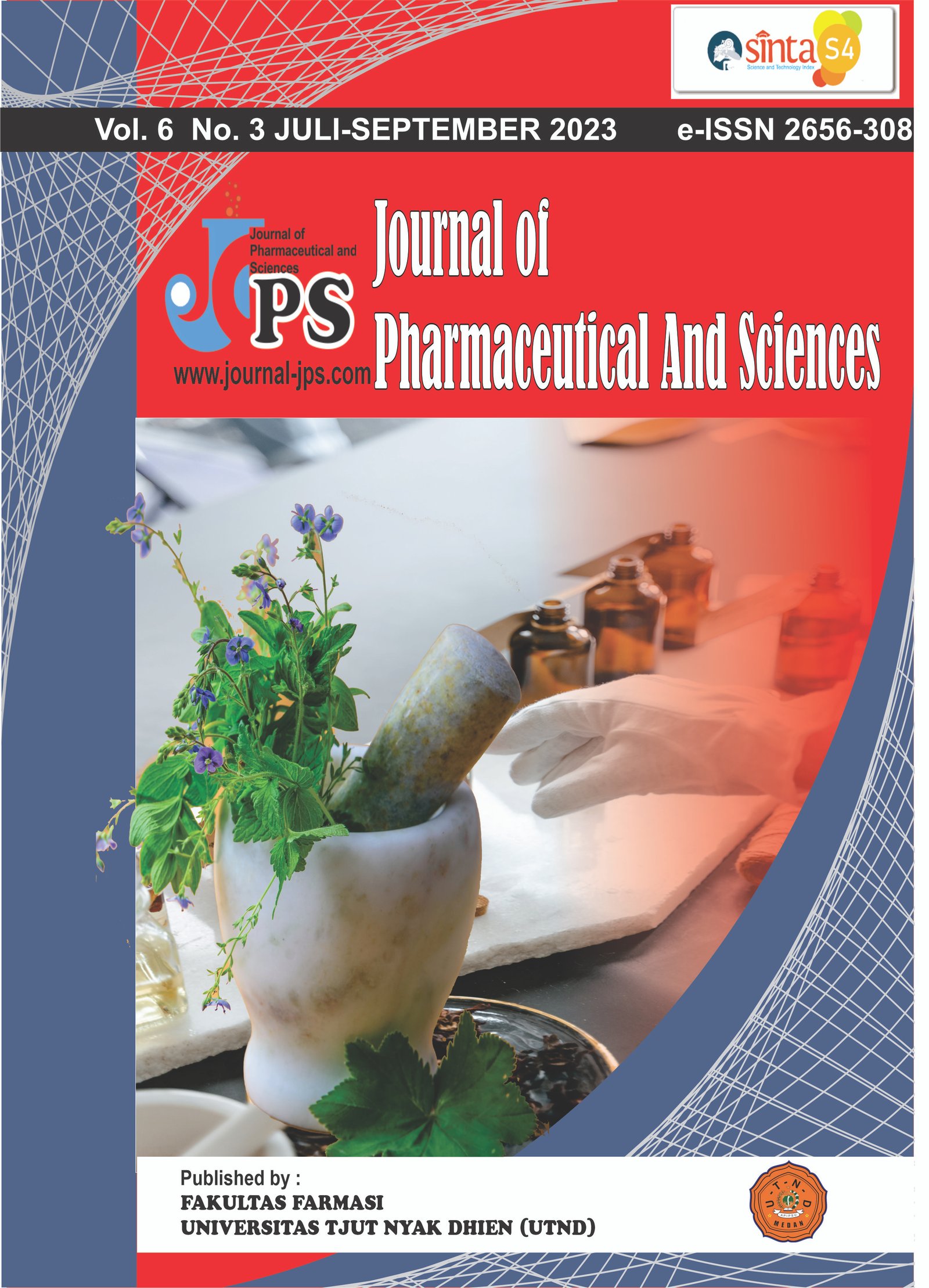Formulation of the preparation of blush on using natural dye copigmentation of annatto (Bixa orellana L.) with red yeast rice
Main Article Content
Page: 1123-1130
Abstract
Background; annatto (Bixa orellana L.) is a plant planted in the house or roadside gardens, containing alkaloids, flavonoids, and carotenoids. Red yeast rice is a natural product from China, resulting from traditional fermentation. This study aims to determine the co-pigmentation of annatto and red yeast rice seeds in the form of ethanol extract, which can be formulated as a natural dye into blush on preparations that, at specific concentrations, produce natural colors that meet the requirements and do not cause skin irritation. Methods; the study used an experimental approach using the test material of annatto seeds (Bixa orellana L.) and red yeast rice. The study was initiated by sampling, plant identification, Simplicia processing, and co-pigmentation of annatto (Bixa orellana L.) and red yeast rice seeds by maceration using 96% ethanol extract, p; phytochemical screening was carried out. The basic modified formulation of blush on a ratio of 1:2 between annatto seeds and red yeast rice seeds was made in 3 preparations with a concentration of 3%, 6%, and 9%, and blank. Examination of the physical quality of the preparation includes color dispersion test (homogeneity), polish test, stability test, and irritation test. Result; the results of the study concluded that the copigmentation of annatto (Bixa orellana L.) seeds and red yeast rice in the form of ethanol extract could be formulated into blush on preparations as natural dyes, which are homogeneous, easy to apply,y and stable for 12 days of storage. Produces different colors depending on the concentration contained in the preparation of the cheek dye. The co-pigmented cheek dyes made from ethanol extract of annatto (Bixa orellana L.) and red yeast rice seeds were non- irritating to the skin.
Downloads
Article Details

This work is licensed under a Creative Commons Attribution-NonCommercial-ShareAlike 4.0 International License.
References
Amantika, R. S., & Syamwil, R. (2021). Pemanfaatan Daun Lengkeng ( Nephelium Logan ) Untuk Pewarna Batik. 10(1). 52–56.
Alfajar, S. H., Salman, S., Zebua, N. F., & Sari, N. (2023). Studi kopigmentasi campuran ekstrak biji kesumba keling (Bixa orellana L.) dengan ekstrak angkak merah. Forte Journal, 3(1), 97-106.
Apriani, I. (2016). Pengembangan Media Belajar: Angkak Beras Merah Dan Teh (Camellia Sinensis) Sebagai Pewarna Alternatif Preparat Basah Jaringan Tumbuhan. Bioilmi: Jurnal Pendidikan. 2(1). 60.
Butar-Butar, M. E. T., Sister, S.,& Fahrudin,G., F. (2023). Formulasi dan Evaluasi Blush on Compact powder Ekstrak Daging Buah Naga (Hylocereus polyrhizus) sebagai Coloring Agent. Majalah Farmasetika, 8(1).
Chatham, L. A., Howard, J. E., & Juvik, J. A. (2020). A natural colorant system from corn: Flavone-anthocyanin copigmentation for altered hues and improved shelf life. Food chemistry, 310, 125734.
He, Y., Wen, L., Yu, H., Zheng, F., Wang, Z., Xu, X., ... & Hao, J. (2018). Effects of high hydrostatic pressure-assisted organic acids on the copigmentation of Vitis amurensis Rupr anthocyanins. Food chemistry, 268, 15-26.
Lestario, L. N., & Andini, S. (2016). Kopigmentasi Kuersetin Apel (Pyrus malus) terhadap Stabilitas Warna Ekstrak Buah Duwet (Syzygium cumini). Prosiding Konser Karya Ilmiah. 2(5). 37–42.
Mamoto, L. V., Fatimawali, F., & Citraningtyas, G. (2013). Analisis rhodamin b pada lipstik yang beredar di pasar kota manado. Pharmacon, 2(2).
Oktaviani, A. E., & Krisnawati, M. (2019). Kelayakan blush on shimmer dengan pewarna alami ekstrak buah bit berbentuk compact. Beauty And Beauty Health Education Journal, 8. 25-29.
Ramani, S., Cahaya Himawan, H., & Kurniawati, N. (2021). Formulasi Sediaan Blush on Ekstrak Kayu Secang (Caesalpiinia Sappan L) Sebagai Pewarna Alami Dalam Bentuk Powder. Jurnal Farmamedika (Pharmamedica Journal). 6(1). 1–9.
Septilita, Y. P., Almeida, M., & Rijai, L. (2022). Optimasi Basis Blush On Cream dengan Variasi Konsentrasi Asam Stearat: Optimization of Blush on Cream Base with Variations in Stearic Acid Concentrations. In Proceeding of Mulawarman Pharmaceuticals Conferences (Proc. Mul. Pharm. Conf.) (Vol. 15, pp. 194-198).
Sianipar, A. Y., Nurbaya, S., Adiansyah, A., & Sitanggang, E. P. (2020). Formulasi Sediaan Blush On Dari Sari Buah Stroberi (Fragaria Vesca L) Sebagai Perona Pipi. Jurnal Farmanesia, 7(1), 5-10.
Sosa-Martínez, J. D., Balagurusamy, N., Montañez, J., Peralta, R. A., Moreira, R. D. F. P. M., Bracht, A., & Morales-Oyervides, L. (2020). Synthetic dyes biodegradation by fungal ligninolytic enzymes: Process optimization, metabolites evaluation and toxicity assessment. Journal of Hazardous Materials, 400, 123254.
Souhoka, F. A., Hattu, N., & Huliselan, M. (2019a). Uji Aktivitas Antioksidan Ekstrak Metanol Biji Kesumba Keling (Bixa orellana L). Indo. J. Chem. Res. 7(1). 25–31.
Tarigan, M., H., Vivi, A., dan Grace, A., G. (2021). Formulation And Evaluation Of The Preparation Of Blush On Cream From Ethanol Extract Flower Kecombrang (Etlingera Elatior (Jack) R.M. Sm.). Jurnal Biosains. 7(2). 103–115.
Wulandari, D., Hanum, T., & Rangga, A. (2018). Copigmentation Effect of Catechol and Tannin on Stability of Glutinous Black Rice Bran (Oryza sativa glutinosa). Jurnal Teknologi & Industri Hasil Pertanian. 23(1). 31.





